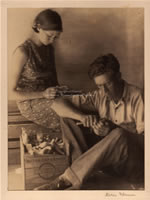The People
During the Craft Revival, the majority of craftsmen were weavers, carvers, and makers of baskets. Their products, lightweight and non-breakable, were suitable for shipping to markets outside the region and appealed to the tourist trade. Furniture and instrument makers required more specialized markets; their work was often sold directly from family workshops. While potters and metalsmiths produced fine crafts during the Revival, their products were heavy and not so easily distributed.
Makers were but one half of the equation that shaped the Craft Revival. Of equal bearing on the movement were its craft promoters, those who supported and sold mountain crafts. For the most part, the individuals who orchestrated the Craft Revival initially came to the region for reasons other than craft promotion. They came as missionaries, teachers, researchers, and mountain workers. Almost all stayed longer than they intended, making their homes in the mountains. They encouraged makers to preserve traditional skills and to produce new works for sale. They opened shops, taught in schools, established cottage industries, and documented craft activity. Some learned craft skills themselves.
Frances Goodrich arrived to establish a Presbyterian mission; Lucy Morgan taught in an Episcopal school. Marguerite Butler was a settlement worker. John Campbell conducted one of the earliest studies of the region; Allen Eaton later made a specialized study of crafts. Olive Campbell and Mary Sloop opened schools. Edward Worst and Louise Pitman were well-known teachers. Eleanor Vance and Charlotte Yale established cottage industries; Clementine Douglas opened a sales shop. Photographers Doris Ulmann and Bayard Wootten captured the likenesses of many in this diverse community of movement leaders and makers.
See More: Read The Story of the Craft Revival and learn about The Crafts. Link to Resources, including a bibliography, lesson plans, and today’s craft organizations.




